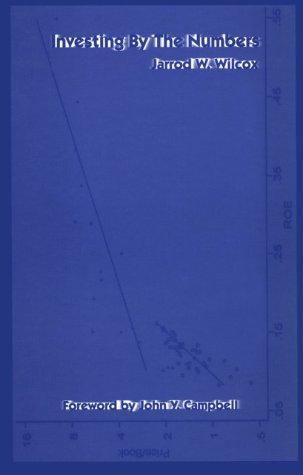
I’m going to be reviewing a few books on quantitative investing.? Many of these will not be suitable for everyone, and as I do these reviews, I will try to indicate what level of math skills you will need in order to benefit from the book.? For today’s book, you can get most of it if you can remember your Algebra 1, and understand basic statistics.? Knowing regression helps, and a little calculus wouldn’t hurt, but this book is mainly qualitative.? It describes,and there are many graphs, but formulas are not on every page.
Investing By The Numbers has been out a while (1999), and though it is a good book in my opinion, it never sold big.? Oddly, a lot of investment actuaries bought the book because of a review in the Investment Section newsletter, Risk and Returns.? I have one of the few signed copies.? When I met Jarrod Wilcox when he gave a talk to the CFA Society of Washington, DC, he was genuinely surprised when I asked him to sign my copy of the book.
Jarrod Wilcox, Ph.D., CFA, held important roles at PanAgora Asset Management and Batterymarch Financial Management.? He runs his own shop now, focusing on liability-driven investing, something that I have written about at RealMoney, and at this blog.? What do I mean by liability driven investing?? Just that your asset allocation should reflect when you will most likely need the money.
This book does not have one big overarching idea to guide it.? Instead, it has many models to share from different situations in the market.? There is something for every quantitative equity investor here, and I will mention the areas where I benefited the most:
- Along with a few other books, including some from the Santa Fe Institute, this book confirmed to me that one has to look at investment using an ecological framework.? Many strategies are competing for scarce returns.? Often the best strategy is the one that has few following it, and the worst one is the crowded trade.
- Why do value methods tend to work?
- How do you avoid traps in calculating models?
- How do investors with different goals and expectations affect the market?? What happens when you get too many momentum investors?? Too many growth investors?
- Difficulties with the Capital Asset Pricing Model [CAPM] and Arbitrage Pricing Theory [APT].
- If the market tends toward equilibrium, the forces guiding it are weak.
- Behavioral finance as a means of bridging investment theory and reality.
- Market microstructure: how do we minimize total trading cost?? Minimize taxes?
- How is the P/B-ROE model derived?
- How to model market anomalies?
- When do different valuation methods pay off well?
- How does international diversification help?? (Bold in 1999, but a bit dated now.)
- How to manage foreign currency risk in an equity portfolio?
- How do neural nets work and what challenges are there in using them?
As a young investor using quantitative methods, I found the book useful, and still use a number of its findings in my current investing. Again, this is not a book for everyone — you have to want to do quantitative investing from primarily a fundamental mindset in order to benefit for this book.
Full Disclosure: Anytime anyone enters Amazon.com through any link on my site and buys anything there, I get a small commission.? This is my version of the tip jar, but best of all, it doesn’t cost you a thing, if you needed to buy it through Amazon already.

I’m into investing, but algebra was not my subject. Better give this one a miss.